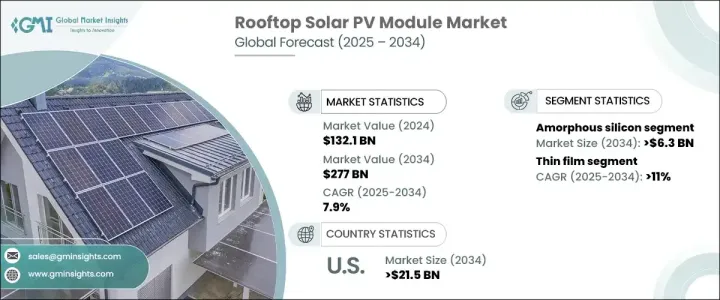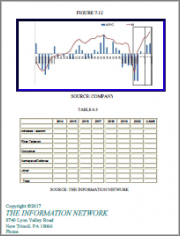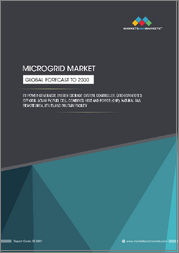
|
시장보고서
상품코드
1685081
옥상 태양광 발전 모듈 시장 기회, 성장 촉진 요인, 산업 동향 분석, 예측(2025-2034년)Rooftop Solar PV Module Market Opportunity, Growth Drivers, Industry Trend Analysis, and Forecast 2025 - 2034 |
||||||
옥상 태양광 발전 모듈 세계 시장은 2024년에 1,321억 달러에 달했고, 2025년부터 2034년에 걸쳐 CAGR은 7.9%를 나타낼 전망입니다.
실리콘과 같은 반도체 재료를 사용하여 태양광을 전력으로 변환하는 옥상 태양광 발전(PV) 모듈은 주택, 상업 및 산업 분야에서 채택이 확대되고 있습니다. 이러한 시스템은 재생 가능 에너지를 현장에서 소비하거나 잉여 에너지를 송전망에 공급할 수 있습니다. 기후 변화에 대한 의식 증가와 온실가스 배출량의 삭감이 급선무가 되고 있는 것이 재생가능에너지 솔루션의 채용을 뒷받침하고 있습니다. 세계 각국의 정부는 태양에너지를 촉진하기 위한 인센티브와 보조금을 도입하여 시장 성장을 더욱 가속화하고 있습니다.

게다가 태양전지 기술의 진보에 의해 에너지 변환 효율이 향상되어, 옥상 태양광 발전 시스템의 비용 효과가 높아져, 이용하기 쉬워지고 있습니다. 지속 가능한 에너지 솔루션에 대한 수요 증가와 에너지 자급의 필요성이 결합되어, 옥상 태양광 발전 모듈은 소비자나 기업에 있어서 바람직한 선택지가 되고 있습니다. 또한, 정전이나 자연재해시의 에너지 회복력을 높이는 분산형 에너지 시스템에 대한 주목이 높아지고 있는 것도, 이 시장의 추풍이 되고 있습니다. 세계 에너지 정세가 보다 깨끗한 대체 에너지로 이동하는 가운데 옥상 태양광 발전 모듈 시장은 예측 기간 동안 큰 성장을 이룰 것으로 기대됩니다.
| 시장 범위 | |
|---|---|
| 시작 연도 | 2024년 |
| 예측 연도 | 2025-2034년 |
| 시작금액 | 1,321억 달러 |
| 예측 금액 | 2,770억 달러 |
| CAGR | 7.9% |
시장은 제품 유형별로 구분되며, 비정질 실리콘 모듈은 2034년까지 63억 달러 시장 규모에 이를 것으로 예측됩니다. 비정질 실리콘 모듈은 기존의 결정 실리콘 패널에 비해 가볍고 유연성이 높기 때문에 다양한 구조에 적합합니다. 분산형 에너지 솔루션을 제공하는 능력은 비상시 에너지 신뢰성을 높이기 위해 주요 성장 요인입니다. 유연하고 적응성이 높은 에너지 시스템에 대한 선호도가 높아지면서 특히 자연 재해가 많은 지역에서 비정질 실리콘 모듈 수요에 박차를 가하고 있습니다.
기술면에서는 옥상 태양광 발전 모듈 시장의 박막 모듈은 2034년까지 연평균 복합 성장률(CAGR) 11%로 성장할 것으로 예상됩니다. 박막 기술은 경량 설계, 설치 용이성, 곡면 등 종래와 다른 형상의 지붕에도 설치할 수 있는 유연성에 의해 지지를 모으고 있습니다. 에너지 변환 효율의 향상과 첨단 재료의 채용을 목표로 하는 박막 기술의 최근의 진보가 이 부문의 성장을 더욱 촉진하고 있습니다. 이러한 기술 혁신으로 박막 모듈은 주거용 및 상업용 모두에서 인기있는 선택이 되었습니다.
미국의 옥상 태양광 발전 모듈 시장은 2034년까지 215억 달러를 창출할 것으로 예측됩니다. 태양광발전시스템 설치에 30%의 세액공제를 제공하는 투자세액공제(ITC) 등 정부의 이니셔티브이 이 성장 추진에 큰 역할을 하고 있습니다. 또한 공급망의 중단과 자연 재해로 인한 에너지 안전 보장에 대한 우려가 소비자에게보다 신뢰성 있고 내구성있는 에너지 솔루션의 채택을 촉진하고 있습니다. 지속가능성과 에너지자급에 대한 관심이 높아짐에 따라 미국의 옥상 태양광 발전 모듈에 대한 수요가 더욱 높아지고 있습니다.
목차
제1장 조사 방법과 조사 범위
- 시장의 정의
- 기본 추정과 계산
- 예측 계산
- 1차 조사와 검증
- 1차 정보
- 데이터 마이닝 소스
- 시장의 정의
제2장 주요 요약
제3장 업계 인사이트
- 업계 에코시스템
- 규제 상황
- 업계에 미치는 영향요인
- 성장 촉진요인
- 업계의 잠재적 위험 및 과제
- 성장 가능성 분석
- Porter's Five Forces 분석
- PESTEL 분석
제4장 경쟁 구도
- 소개
- 전략 대시보드
- 혁신과 지속가능성의 전망
제5장 시장 규모와 예측 : 기술별, 2021년-2034년
- 주요 동향
- 박막
- 결정 실리콘
제6장 시장 규모와 예측 : 제품별, 2021년-2034년
- 주요 동향
- 단결정
- 다결정
- 카드뮴 텔룰라이드
- 비정질 실리콘
- 구리 인듐 갈륨 디셀렌화물
제7장 시장 규모와 예측 : 커넥티비티별, 2021년-2034년
- 주요 동향
- 온그리드
- 오프 그리드
제8장 시장 규모와 예측 : 최종 용도별, 2021년-2034년
- 주요 동향
- 주택용
- 상업 및 산업
- 유틸리티
제9장 시장 규모와 예측 : 지역별, 2021년-2034년
- 주요 동향
- 북미
- 미국
- 캐나다
- 멕시코
- 유럽
- 오스트리아
- 노르웨이
- 덴마크
- 핀란드
- 프랑스
- 독일
- 영국
- 아시아태평양
- 중국
- 호주
- 인도
- 일본
- 한국
- 중동
- 이스라엘
- 사우디아라비아
- 아랍에미리트(UAE)
- 요르단
- 오만
- 아프리카
- 남아프리카
- 이집트
- 알제리
- 나이지리아
- 모로코
- 라틴아메리카
- 브라질
- 칠레
- 아르헨티나
- 페루
제10장 기업 프로파일
- Canadian Solar
- EMMVEE SOLAR
- Hanwha Group
- Indosolar
- JA Solar Technology
- JinkoSolar
- LONGi
- Motech Industries
- REC Solar Holdings
- RENESOLA
- Risen Energy
- Shunfeng International Clean Energy
- SunPower Corporation
- Trina Solar
- Vikram Solar
- Yingli Solar
The Global Rooftop Solar PV Module Market reached USD 132.1 billion in 2024 and is projected to grow at a CAGR of 7.9% from 2025 to 2034. Rooftop solar photovoltaic (PV) modules, which convert sunlight into electricity using semiconductor materials like silicon, are increasingly being adopted across residential, commercial, and industrial sectors. These systems provide renewable energy for on-site consumption or can feed surplus energy back into the grid. The growing awareness of climate change and the urgent need to reduce greenhouse gas emissions are driving the adoption of renewable energy solutions. Governments worldwide are introducing incentives and subsidies to promote solar energy, further accelerating market growth.

Additionally, advancements in solar technology are improving energy conversion efficiency, making rooftop solar PV systems more cost-effective and accessible. The rising demand for sustainable energy solutions, coupled with the need for energy independence, is positioning rooftop solar PV modules as a preferred choice for consumers and businesses alike. The market is also benefiting from the increasing focus on decentralized energy systems, which enhance energy resilience during power outages and natural disasters. As the global energy landscape shifts towards cleaner alternatives, the rooftop solar PV module market is expected to witness significant growth during the forecast period.
| Market Scope | |
|---|---|
| Start Year | 2024 |
| Forecast Year | 2025-2034 |
| Start Value | $132.1 Billion |
| Forecast Value | $277 Billion |
| CAGR | 7.9% |
The market is segmented by product type, with amorphous silicon modules projected to generate USD 6.3 billion by 2034. These modules are lighter and more flexible compared to traditional crystalline silicon panels, making them suitable for a wide range of structures. Their ability to provide decentralized energy solutions is a key growth driver, as they enhance energy reliability during emergencies. The growing preference for flexible and adaptable energy systems is fueling the demand for amorphous silicon modules, particularly in regions prone to natural disasters.
In terms of technology, the thin film segment of the rooftop solar PV module market is expected to grow at an impressive 11% CAGR through 2034. Thin film technology is gaining traction due to its lightweight design, ease of installation, and flexibility, which allows it to be installed on rooftops with unconventional shapes, such as curved surfaces. Recent advancements in thin film technology, aimed at improving energy conversion efficiency and incorporating advanced materials, are further driving the growth of this segment. These innovations are making thin film modules a popular choice for both residential and commercial applications.
The U.S. rooftop solar PV module market is projected to generate USD 21.5 billion by 2034. Government initiatives, such as the Investment Tax Credit (ITC), which offers a 30% tax credit for solar system installations, are playing a significant role in driving this growth. Additionally, concerns over energy security, heightened by supply chain disruptions and natural disasters, are pushing consumers to adopt more reliable and durable energy solutions. The increasing focus on sustainability and energy independence is further boosting the demand for rooftop solar PV modules in the United States.
Table of Contents
Chapter 1 Methodology & Scope
- 1.1 Market definitions
- 1.2 Base estimates & calculations
- 1.3 Forecast calculation
- 1.4 Primary research & validation
- 1.4.1 Primary sources
- 1.4.2 Data mining sources
- 1.5 Market Definitions
Chapter 2 Executive Summary
- 2.1 Industry synopsis, 2021 – 2034
Chapter 3 Industry Insights
- 3.1 Industry ecosystem
- 3.2 Regulatory landscape
- 3.3 Industry impact forces
- 3.3.1 Growth drivers
- 3.3.2 Industry pitfalls & challenges
- 3.4 Growth potential analysis
- 3.5 Porter's analysis
- 3.5.1 Bargaining power of suppliers
- 3.5.2 Bargaining power of buyers
- 3.5.3 Threat of new entrants
- 3.5.4 Threat of substitutes
- 3.6 PESTEL analysis
Chapter 4 Competitive landscape, 2024
- 4.1 Introduction
- 4.2 Strategic dashboard
- 4.3 Innovation & sustainability landscape
Chapter 5 Market Size and Forecast, By Technology, 2021 – 2034 (USD Billion & MW)
- 5.1 Key trends
- 5.2 Thin film
- 5.3 Crystalline silicon
Chapter 6 Market Size and Forecast, By Product, 2021 – 2034 (USD Billion & MW)
- 6.1 Key trends
- 6.2 Monocrystalline
- 6.3 Polycrystalline
- 6.4 Cadmium telluride
- 6.5 Amorphous silicon
- 6.6 Copper indium gallium Di-Selenide
Chapter 7 Market Size and Forecast, By Connectivity, 2021 – 2034 (USD Billion & MW)
- 7.1 Key trends
- 7.2 On-Grid
- 7.3 Off-Grid
Chapter 8 Market Size and Forecast, By End Use, 2021 – 2034 (USD Billion & MW)
- 8.1 Key trends
- 8.2 Residential
- 8.3 Commercial & Industrial
- 8.4 Utility
Chapter 9 Market Size and Forecast, By Region, 2021 – 2034 (USD Billion & MW)
- 9.1 Key trends
- 9.2 North America
- 9.2.1 U.S.
- 9.2.2 Canada
- 9.2.3 Mexico
- 9.3 Europe
- 9.3.1 Austria
- 9.3.2 Norway
- 9.3.3 Denmark
- 9.3.4 Finland
- 9.3.5 France
- 9.3.6 Germany
- 9.3.7 UK
- 9.4 Asia Pacific
- 9.4.1 China
- 9.4.2 Australia
- 9.4.3 India
- 9.4.4 Japan
- 9.4.5 South Korea
- 9.5 Middle East
- 9.5.1 Israel
- 9.5.2 Saudi Arabia
- 9.5.3 UAE
- 9.5.4 Jordan
- 9.5.5 Oman
- 9.6 Africa
- 9.6.1 South Africa
- 9.6.2 Egypt
- 9.6.3 Algeria
- 9.6.4 Nigeria
- 9.6.5 Morocco
- 9.7 Latin America
- 9.7.1 Brazil
- 9.7.2 Chile
- 9.7.3 Argentina
- 9.7.4 Peru
Chapter 10 Company Profiles
- 10.1 Canadian Solar
- 10.2 EMMVEE SOLAR
- 10.3 Hanwha Group
- 10.4 Indosolar
- 10.5 JA Solar Technology
- 10.6 JinkoSolar
- 10.7 LONGi
- 10.8 Motech Industries
- 10.9 REC Solar Holdings
- 10.10 RENESOLA
- 10.11 Risen Energy
- 10.12 Shunfeng International Clean Energy
- 10.13 SunPower Corporation
- 10.14 Trina Solar
- 10.15 Vikram Solar
- 10.16 Yingli Solar



















